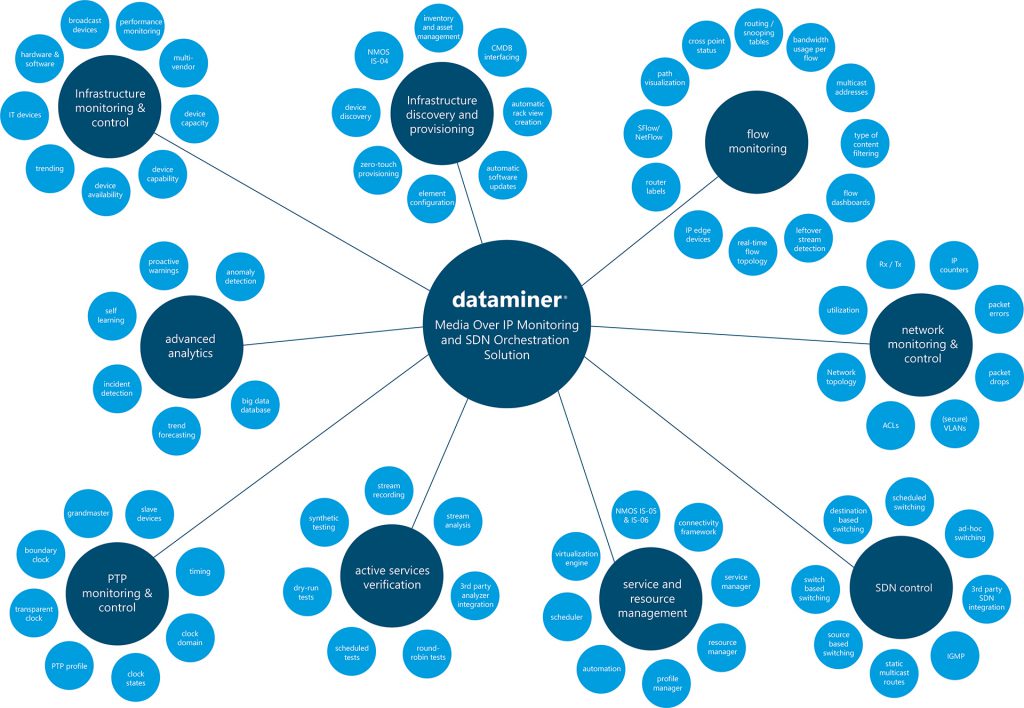
The challenge
With the ongoing migration in the broadcast & media industry towards an ALL-IP infrastructure, media companies are facing plenty of new and very fundamental challenges. The move to ALL-IP is not just another shift in technology, like the migration from SD to HD. This time, operational procedures need to evolve as well and new tools need to be developed to automate and support those.
One of the ongoing quests in the broadcast industry is how to monitor and visualize uncompressed multicast streams end to end. While with SMPTE ST 2022-6, the number of streams is similar to the number of signals you had in the HD-SDI world, an SMTPE ST 2110 environment multiplies the number of streams that need to be monitored, tracked and analyzed.
It’s not only the proliferation of signals (flows) that media-over-IP installations entail, it’s also the overall unprecedented complexity of a network fabric that requires new solutions and strategies to monitor all video, audio and metadata flows. A single network connection can carry several signals, and the routes those signals take from source to destination are not necessarily always the same, especially in large spine-leaf network architectures. The common “follow the green cable” rule, which worked perfectly well in SDI, does not apply any longer. In addition, signal switching often does not have to happen in the switch itself anymore, as other technologies like source-based or destination-based switching are used as well. As this is just the tip of the iceberg, it is more than obvious that ALL-IP installations, which consist of plenty of different technologies, from different vendors and using different protocols, absolutely require an open and flexible end-to-end multi-vendor monitoring and platform to properly operate and leverage it in today’s competitive market.
The solution
It all starts with full real-time monitoring and control across all products, software and hardware, broadcast and IT. Including for example broadcast IP devices like IP multi-viewers and monitors, cameras, graphics devices, video servers, video and audio processing devices, the IP network infrastructure, storage nodes, and so on, to monitor the health status and to retrieve KPIs, such as utilization rates of network interfaces or CPU usage of software-based edge devices.
Operators are used to working with labels for every source and destination, so being able to interface with the systems managing those, typically broadcast controllers, is a key factor. SDN controller databases keep the information of which edge devices represent which input and output. A deeply integrated monitoring system talks to such a controller and to any edge device from any vendor to dynamically check the IP addresses and the unicast or multicast addresses the transmitters are set to. Flow technologies like sFlow or netFlow are used to detect in real time where these multicast streams effectively occur for every single network ingress interface. By also reading routing and snooping tables via the switch vendor’s native APIs to check the traffic on the egress interface, the path of every flow can be visualized, so that a full picture from source to each destination is presented in real time to operators. The destination edge device itself must be checked as well for its multicast receiving IP addresses. And all this must happen for both the main and the backup streams in an SMPTE ST 2022-7 installation.
Only with a concept to consolidate all those data sources into a single vendor-agnostic application, can flows be monitored and visualized in an efficient and future-proof manner. Those real-time flow topologies can then be cross-checked against the cross-point status tables of an SDN controller to detect switches that did not happen and to even catch flows that should not be active anymore, i.e. leftovers that can occur in an IGMP-based setup whenever an IGMP leave was not successful.
A modern ALL-IP monitoring solution also integrates with TAP aggregators and third-party stream analyzers to automatically mirror interfaces and send problematic streams automatically to such analyzers, for IP, video and audio quality verification.
Last but not least, end-to-end dashboards and reports provide an additional level and true 360° visibility on a media network. Again, xFlow technologies play an important role here, providing insight into the actual traffic flowing across the network, to resolve intermittent network performance issues and to ensure quality of service (QoS), not only for the uncompressed video and audio streams, but also for all kinds of other network traffic. Easy identification of historical trends and abnormal bandwidth usage ensures that the network can be proactively secured.
More than ever, a single consolidated and agile network management and orchestration platform is a strategic key to successfully make the transition to media over IP in the broadcast industry. It is an effective response to always know where your streams are and how they behave in the network.